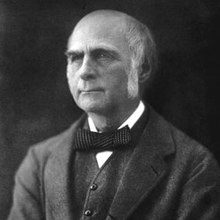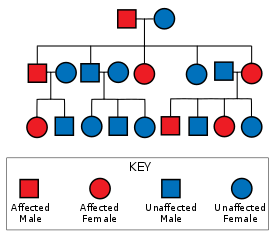
A | B | C | D | E | F | G | H | CH | I | J | K | L | M | N | O | P | Q | R | S | T | U | V | W | X | Y | Z | 0 | 1 | 2 | 3 | 4 | 5 | 6 | 7 | 8 | 9
| Part of a series on |
| Psychology |
|---|
Behavioural genetics, also referred to as behaviour genetics, is a field of scientific research that uses genetic methods to investigate the nature and origins of individual differences in behaviour. While the name "behavioural genetics" connotes a focus on genetic influences, the field broadly investigates the extent to which genetic and environmental factors influence individual differences, and the development of research designs that can remove the confounding of genes and environment. Behavioural genetics was founded as a scientific discipline by Francis Galton in the late 19th century, only to be discredited through association with eugenics movements before and during World War II. In the latter half of the 20th century, the field saw renewed prominence with research on inheritance of behaviour and mental illness in humans (typically using twin and family studies), as well as research on genetically informative model organisms through selective breeding and crosses. In the late 20th and early 21st centuries, technological advances in molecular genetics made it possible to measure and modify the genome directly. This led to major advances in model organism research (e.g., knockout mice) and in human studies (e.g., genome-wide association studies), leading to new scientific discoveries.
Findings from behavioural genetic research have broadly impacted modern understanding of the role of genetic and environmental influences on behaviour. These include evidence that nearly all researched behaviours are under a significant degree of genetic influence, and that influence tends to increase as individuals develop into adulthood. Further, most researched human behaviours are influenced by a very large number of genes and the individual effects of these genes are very small. Environmental influences also play a strong role, but they tend to make family members more different from one another, not more similar.
History

Selective breeding and the domestication of animals is perhaps the earliest evidence that humans considered the idea that individual differences in behaviour could be due to natural causes.[1] Plato and Aristotle each speculated on the basis and mechanisms of inheritance of behavioural characteristics.[2] Plato, for example, argued in The Republic that selective breeding among the citizenry to encourage the development of some traits and discourage others, what today might be called eugenics, was to be encouraged in the pursuit of an ideal society.[2][3] Behavioural genetic concepts also existed during the English renaissance, where William Shakespeare perhaps first coined the phrase "nature versus nurture" in The Tempest, where he wrote in Act IV, Scene I, that Caliban was "A devil, a born devil, on whose nature Nurture can never stick".[3][4]
Modern-day behavioural genetics began with Sir Francis Galton, a nineteenth-century intellectual and cousin of Charles Darwin.[3] Galton was a polymath who studied many subjects, including the heritability of human abilities and mental characteristics. One of Galton's investigations involved a large pedigree study of social and intellectual achievement in the English upper class. In 1869, 10 years after Darwin's On the Origin of Species, Galton published his results in Hereditary Genius.[5] In this work, Galton found that the rate of "eminence" was highest among close relatives of eminent individuals, and decreased as the degree of relationship to eminent individuals decreased. While Galton could not rule out the role of environmental influences on eminence, a fact which he acknowledged, the study served to initiate an important debate about the relative roles of genes and environment on behavioural characteristics. Through his work, Galton also "introduced multivariate analysis and paved the way towards modern Bayesian statistics" that are used throughout the sciences—launching what has been dubbed the "Statistical Enlightenment".[6]

The field of behavioural genetics, as founded by Galton, was ultimately undermined by another of Galton's intellectual contributions, the founding of the eugenics movement in 20th century society.[3] The primary idea behind eugenics was to use selective breeding combined with knowledge about the inheritance of behaviour to improve the human species.[3] The eugenics movement was subsequently discredited by scientific corruption and genocidal actions in Nazi Germany. Behavioural genetics was thereby discredited through its association to eugenics.[3] The field once again gained status as a distinct scientific discipline through the publication of early texts on behavioural genetics, such as Calvin S. Hall's 1951 book chapter on behavioural genetics, in which he introduced the term "psychogenetics",[7] which enjoyed some limited popularity in the 1960s and 1970s.[8][9] However, it eventually disappeared from usage in favour of "behaviour genetics".
The start of behaviour genetics as a well-identified field was marked by the publication in 1960 of the book Behavior Genetics by John L. Fuller and William Robert (Bob) Thompson.[1][10] It is widely accepted now that many if not most behaviours in animals and humans are under significant genetic influence, although the extent of genetic influence for any particular trait can differ widely.[11][12] A decade later, in February 1970, the first issue of the journal Behavior Genetics was published and in 1972 the Behavior Genetics Association was formed with Theodosius Dobzhansky elected as the association's first president. The field has since grown and diversified, touching many scientific disciplines.[3][13]
Methods
The primary goal of behavioural genetics is to investigate the nature and origins of individual differences in behaviour.[3] A wide variety of different methodological approaches are used in behavioural genetic research,[14] only a few of which are outlined below.
Animal studies
This section needs expansion. You can help by adding to it. (February 2020) |
Investigators in animal behaviour genetics can carefully control for environmental factors and can experimentally manipulate genetic variants, allowing for a degree of causal inference that is not available in studies on human behavioural genetics.[15] In animal research selection experiments have often been employed. For example, laboratory house mice have been bred for open-field behaviour,[16] thermoregulatory nesting,[17] and voluntary wheel-running behaviour.[18] A range of methods in these designs are covered on those pages. Behavioural geneticists using model organisms employ a range of molecular techniques to alter, insert, or delete genes. These techniques include knockouts, floxing, gene knockdown, or genome editing using methods like CRISPR-Cas9.[19] These techniques allow behavioural geneticists different levels of control in the model organism's genome, to evaluate the molecular, physiological, or behavioural outcome of genetic changes.[20] Animals commonly used as model organisms in behavioural genetics include mice,[21] zebra fish,[22] and the nematode species C. elegans.[23]
Machine learning and A.I. developments are allowing researchers to design experiments that are able to manage the complexity and large data sets generated, allowing for increasingly complex behavioural experiments. [24]
Human studies
Some research designs used in behavioural genetic research are variations on family designs (also known as pedigree designs), including twin studies and adoption studies.[14] Quantitative genetic modelling of individuals with known genetic relationships (e.g., parent-child, sibling, dizygotic and monozygotic twins) allows one to estimate to what extent genes and environment contribute to phenotypic differences among individuals.[25]
Twin and family studies

The basic intuition of the twin study is that monozygotic twins share 100% of their genome and dizygotic twins share, on average, 50% of their segregating genome. Thus, differences between the two members of a monozygotic twin pair can only be due to differences in their environment, whereas dizygotic twins will differ from one another due to environment as well as genes. Under this simplistic model, if dizygotic twins differ more than monozygotic twins it can only be attributable to genetic influences. An important assumption of the twin model is the equal environment assumption[26] that monozygotic twins have the same shared environmental experiences as dizygotic twins. If, for example, monozygotic twins tend to have more similar experiences than dizygotic twins—and these experiences themselves are not genetically mediated through gene-environment correlation mechanisms—then monozygotic twins will tend to be more similar to one another than dizygotic twins for reasons that have nothing to do with genes.[27]
Twin studies of monozygotic and dizygotic twins use a biometrical formulation to describe the influences on twin similarity and to infer heritability.[25][28] The formulation rests on the basic observation that the variance in a phenotype is due to two sources, genes and environment. More formally, , where is the phenotype, is the effect of genes, is the effect of the environment, and is a gene by environment interaction. The term can be expanded to include additive (), dominance (), and epistatic () genetic effects. Similarly, the environmental term can be expanded to include shared environment () and non-shared environment (), which includes any measurement error. Dropping the gene by environment interaction for simplicity (typical in twin studies) and fully decomposing the and terms, we now have . Twin research then models the similarity in monozygotic twins and dizygotic twins using simplified forms of this decomposition, shown in the table.[25]
| Type of relationship | Full decomposition | Falconer's decomposition |
|---|---|---|
| Perfect similarity between siblings | ||
| Monozygotic twin correlation() | ||
| Dizygotic twin correlation () | ||
| Where is an unknown (probably very small) quantity. | ||
The simplified Falconer formulation can then be used to derive estimates of ,
Antropológia
Aplikované vedy
Bibliometria
Dejiny vedy
Encyklopédie
Filozofia vedy
Forenzné vedy
Humanitné vedy
Knižničná veda
Kryogenika
Kryptológia
Kulturológia
Literárna veda
Medzidisciplinárne oblasti
Metódy kvantitatívnej analýzy
Metavedy
Metodika
Text je dostupný za podmienok Creative
Commons Attribution/Share-Alike License 3.0 Unported; prípadne za ďalších
podmienok.
Podrobnejšie informácie nájdete na stránke Podmienky
použitia.
www.astronomia.sk | www.biologia.sk | www.botanika.sk | www.dejiny.sk | www.economy.sk | www.elektrotechnika.sk | www.estetika.sk | www.farmakologia.sk | www.filozofia.sk | Fyzika | www.futurologia.sk | www.genetika.sk | www.chemia.sk | www.lingvistika.sk | www.politologia.sk | www.psychologia.sk | www.sexuologia.sk | www.sociologia.sk | www.veda.sk I www.zoologia.sk




















